- Home
- Views On News
- Dec 10, 2022 - 5 Banking Stocks to Watch Out for Potential Multibagger Returns
5 Banking Stocks to Watch Out for Potential Multibagger Returns

Private and public banks posted robust results for the September 2022 quarter. There is a new wave of optimism surrounding the Indian banking sector stocks.
Twelve public sector banks reported an average of 50% YoY growth in net profit while private banks reported a jump of 67% YoY.
This came on the back of a steady increase in net interest income and lower provisions. Asset quality also improved.
While growth opportunities in the banking sector may be few and far between, Indian banks are now expected to offer multifold returns on the back of solid credit growth.
Here are 5 banking stocks to watch out for as potential multibaggers in the future.
Here are five.
#1 HDFC Bank
First, on our list is HDFC Bank, India's largest private sector bank by assets and by market capitalisation.
The bank, despite having less than 10% share of the banking sector, is one of the most respected banks in the country.
It relies on a model of wide franchise and low-cost deposit base. This ensures good pricing power and sustainability of above average NIMs (net interest margins).
As a result, the bank has always reported consistently good earnings. HDFC Bank's net profits have grown at a CAGR of 15.9% in the last five years.
This has in turn led to high return ratios compared to its peers. The bank's return on equity (RoE) has averaged at 15% in the last five years.
It is also extremely conservative with its margins and provisioning policies. Therefore, it comes as no surprise that HDFC Bank's net NPAs have never crossed 0.5% of its loans.
In the September 2022 quarter, the bank reported a 20% YoY increase in standalone profit.
The bank's net interest income (NII) grew 18.9% YoY driven by growth in advances. Net interest margin came in at 4.1%, the highest in the last six quarters.
HDFC Bank has said that it is focussing on deposit mobilisation and branch expansion to drive growth. The bank added 121 branches during the September 2022 quarter and 157 in the first half of the financial year 2023. It plans to open 521 branches in the second half.
It is also looking at deposit mobilisation to raise funds to repay the loans taken by HDFC after the merger.
The management said it might complete its planned merger with HDFC ahead of time by the first quarter of the financial year 2024 instead of the original target of the third quarter.
It also taking continuous digital initiatives to enhance customer relations and add value to the customers.
To know more about the bank, check out its financial factsheet and latest quarterly results.
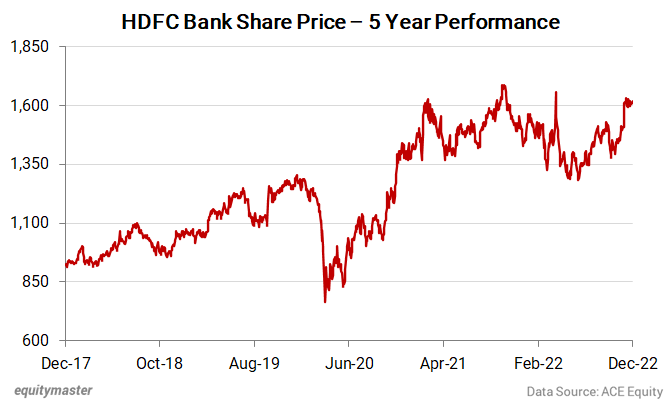
#2 Kotak Mahindra Bank
Second on our list is Kotak Mahindra Bank
The bank is the third largest Indian private sector bank by market capitalisation. It offers products and financial services for corporate and retail customers in the areas of personal finance, investment banking, life insurance, and wealth management.
Over the last couple of years, Kotak Mahindra Bank has demonstrated a highly consistent and healthy historical track record.
The bank's net profit has grown at a CAGR of 15.2% in the last five years. This has been supported by a healthy contribution of low-cost deposits (current and savings accounts).
Its ROE has averaged at 12.4% over the same period.
Besides this, the bank has sustained net NPAs below 1.5% of its loan book all these years. Its institutional memory of tiding over one credit crisis after the other for nearly 25 years has served it well.
In the September 2022 quarter, Kotak Mahindra Bank reported a 27% YoY rise in standalone net profit as it reduced its provisions.
Net interest income (NII) grew 26.8% YoY and net interest margins witnessed sequential expansion of 25 basis points at 5.17% due to robust growth in advances.
The bank aims to accelerate its deposit engine through deeper engagement with retail customers, aggressively tapping customers, and building its institutional (including government) business and scaling up salaried customer base.
However, it remains selective in the corporate segment given continued irrationality in pricing.
To know more about the bank, check out its financial factsheet and latest quarterly results.
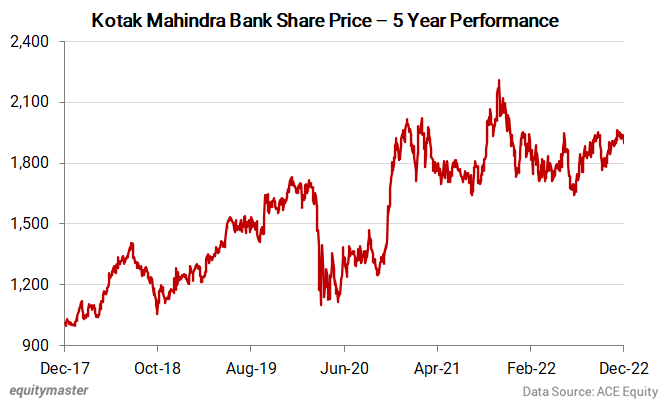
#3 IDFC First Bank
Third on our list is IDFC First Bank.
The bank was founded by the merger of erstwhile IDFC Bank and erstwhile Capital First in 2018.
IDFC Bank was in the business of lending for infrastructure projects while Capital First was an Indian non-bank financial company (NBFC) providing debt financing to small entrepreneurs, MSMEs (Micro, Small and Medium Enterprises), and Indian consumers.
In December 2018, they merged, creating a combined loan asset book of Rs 1.1 tn for the merged entity.
Capital First had portfolios such as loan against shares with ticket sizes above Rs 2 m and loans with annual interest payments, which were allowed for NBFCs but not allowed for banks.
On merger with the bank, an exemption was provided by the RBI for the said portfolio, due to which the bank had to make additional provisions.
IDFC First made 100% provisions against these loans amounting to Rs 890 m.
While it doesn't have a proven track record with respect to its profitability and return ratios, the bank has bright prospects.
The bank's balance sheet is now clean. It is also transforming into a retail focused high NIM bank from a corporate focussed low net interest margin (NIM) bank.
It has developed multiple and diversified streams of income in the bank across Fast Tag, Cash management, wealth management and continues to launch new business lines.
For the September 2022 quarter, IDFC First Bank reported a 266% YoY jump in net profit at Rs 5.6 bn. This was led by a significant improvement in all key metrics such as higher net interest income (NII), robust retail deposit growth, and lower cost ratios.
The bank's net interest income grew by 32% YoY driven by a combination of strong loan growth of 32% YoY along with an expansion in net interest margin (NIM) to 5.98%.
The bank is confident of maintaining margins at this level as it seeks to utilize the benefits of lower cost of funds by migrating to safer customer segments.
The bank's management has guided for 25% YoY growth in loans and 50% YoY rise in core pre operating profit in the financial year 2023.
To know more about the bank, check out its financial factsheet and latest financial results.
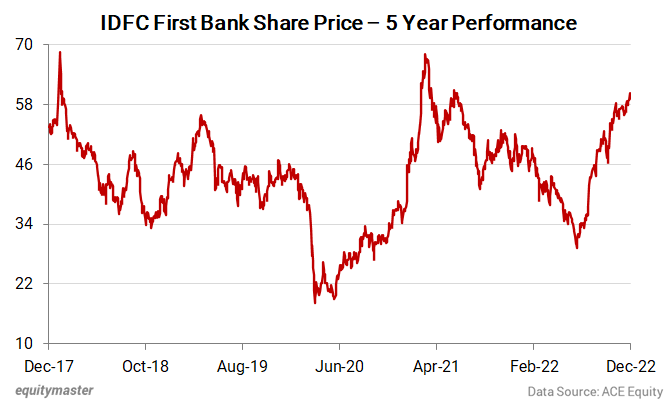
#4 State Bank of India (SBI)
Fourth on the list is State Bank of India, India's largest banking institution.
The bank descends from the Bank of Calcutta, founded in 1806 via the Imperial Bank of India, making it the oldest commercial bank in the Indian Subcontinent.
While the bank has had a chequered past, it has turned its financials around.
The bank has multiplied its profit by 15 times in the last year, reporting a 3-year CAGR of 149%. The asset quality is also healthy, as depicted by the net non-performing assets (NPA) stands at 0.8%.
All of this has trickled down to strong return numbers. The RoE has soared from -2.6% in the financial year ending 2018 to 11.6% in the financial year 2022.
The stock price reflects the financial giant's stellar performance. It has been one of the top performers in the past five years, generating a return of 76.3%, leaving private sector big-wigs HDFC bank (65.5%) and Axis Bank (59.8%) behind.
In the latest quarterly results, SBI reported a 74% YoY rise in net profit. Net interest income rose 12.8% YoY as yields expanded.
The financial giant has been actively funding capex for infrastructure projects and should benefit the most as the capex boom pans out. The infrastructure segment accounts for nearly 15% of the loans disbursed by the company.
To know more about the bank, check out its financial factsheet and latest quarterly results.
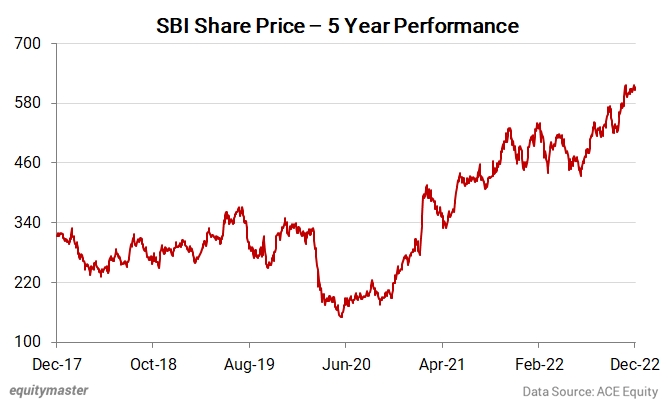
#5 Bandhan Bank
Last on our list is Bandhan Bank.
The bank provides last-mile banking services to the unbanked and under-banked segments of the population. It used to be India's largest non-banking financial company-microfinance institution (NBFC-MFI).
Bandhan Bank's net profit has degrowth in the last five years as the bank had to make additional provisions to cover its bad loans. As a result, return ratios were also impacted.
The bank's asset quality saw a spike during the pandemic as the gross non-performing asset (GNPA) ratio jumped from 1.18% to 6.81% during the March 2021 quarter.
While this is still a concern (gross NPAs stand at 7.2% as of September 2022), it has been improving sequentially on the back of higher write-offs.
The bank's management has said that it expects the asset quality to normalise going forward on the back of improving collection efficiencies. Collection efficiency (CE) has improved to 96% from 94% in the previous quarter.
For the September 2022 quarter, Bandhan Bank registered a net profit of Rs 2.1 bn on the back of lower provisions. The bank had registered a loss of Rs 30 bn in the same period last year.
Net interest income also increased by 13.3% YoY.
Since it already has an established track record in the microfinance industry, it stands to benefit from the huge untapped potential in the microcredit space.
To know more about the bank, check out its financial factsheet and latest quarterly results.
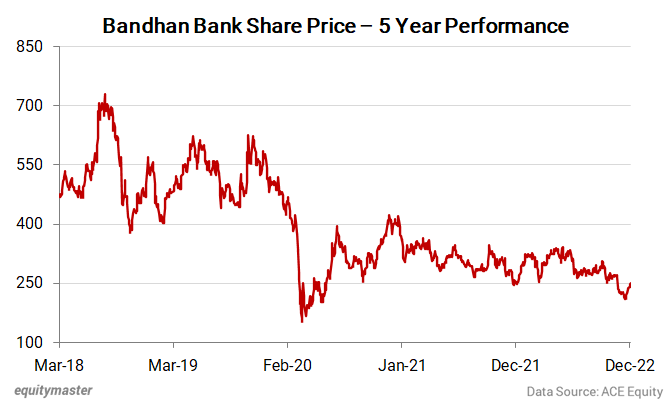
To conclude
Banking stocks will always be a safe haven for investors as banks form the backbone of the economy. However, like every other sector, not all stocks are worth looking into.
Do your own research before investing any money into any. Make sure to thoroughly check their financial statements.
More importantly, do not let yourself get blinded by high valuations or general hype, and only invest in banks with strong fundamentals.
Safe Stocks to Ride India's Lithium Megatrend
Lithium is the new oil. It is the key component of electric batteries.
There is a huge demand for electric batteries coming from the EV industry, large data centres, telecom companies, railways, power grid companies, and many other places.
So, in the coming years and decades, we could possibly see a sharp rally in the stocks of electric battery making companies.
If you're an investor, then you simply cannot ignore this opportunity.
Details of our SEBI Research Analyst registration are mentioned on our website - www.equitymaster.comDisclaimer: This article is for information purposes only. It is not a stock recommendation and should not be treated as such. Learn more about our recommendation services here...

Ayesha Shetty is a financial writer with the StockSelect team at Equitymaster. An engineer by qualification, she uses her analytical skills to decode the latest developments in financial markets. This reflects in her well-researched and insightful articles. When she is not busy separating financial fact from fiction, she can be found reading about new trends in technology and international politics.


Equitymaster requests your view! Post a comment on "5 Banking Stocks to Watch Out for Potential Multibagger Returns". Click here!
Comments are moderated by Equitymaster, in accordance with the Terms of Use, and may not appear
on this article until they have been reviewed and deemed appropriate for posting.
In the meantime, you may want to share this article with your friends!